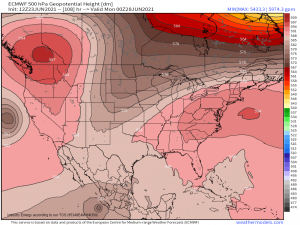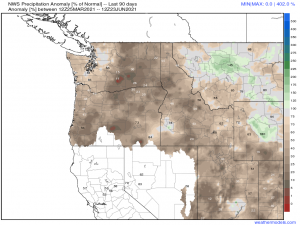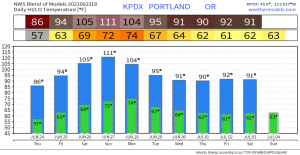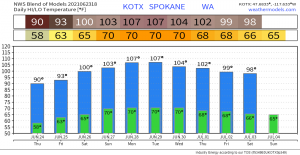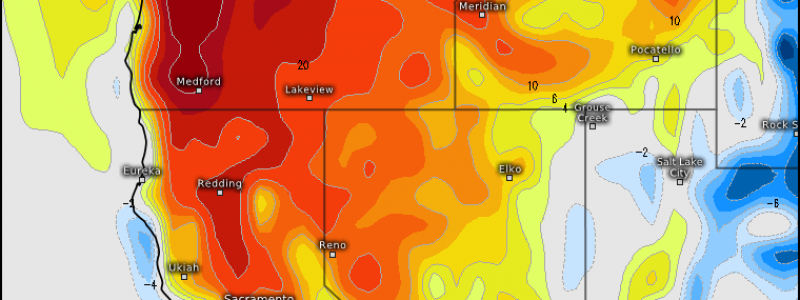
Dangerous, Potentially Record Heat Eyes the Northwest
It’s becoming rather clear at this point that, unless the formation of high-category hurricane occurs suddenly (unlikely), the western heat wave will be the number one weather story this week and next.
Now, Jacob already wrote about this subject yesterday, so I encourage you to go give his well thought out blog a read if you haven’t yet. As he mentioned, it seems the stars are all aligning to produce what could potentially be a memorable event.
We have an anomalous ridge building in:
In fact, every single model has the ridge at/just shy of that magical, not-often-seen 600 dm height. If you’ll recall from a discussion about the southwest heatwave a week or two ago, this is a height not often reached by the 500 mb level and indicates some seriously hot air below.
Beyond that, we have a blocking pattern preventing the ridge from clearing and flushing out the heat.
And, one more factor to further exacerbate conditions: significant drought.
Over the last 90 days, much of the region in question has received 50% or less of their average rainfall. Combine that with drought conditions that were already present beforehand… Well, you see where I’m going with this.
Heat is often mitigated by evaporation. Of the incoming solar energy, a certain amount is allotted to evaporation. This is a bit of a watered-down version but: When the soil is wet or even damp, some of the sun’s energy goes to fulfilling part of the water budget through evaporation while the rest is used to warm the surface. When there is no moisture to evaporate, there is nothing for that reserved energy to do other than warm the surface, leading to more heat.
Think of it this way: you’re sunbathing on a float in the pool. you splash your skin to keep it cool. Eventually, that water evaporates. If you don’t add more water to your skin, sooner or later you feel the tell-tale burn of the sun’s rays heating up your skin. It works the same way, though on a larger, more complicated, scale (obviously) for the Earth.
Although the models have calmed down some and aren’t putting out values that are quite as extreme, there is still a chance that for some, especially in the Pacific Northwest, this will be a rather significant heat wave.
For example, take Portland, Oregon. Portland’s all-time high temperature is 107 degrees. They have reached this value three times: once in 1965 and twice in 1981. The predicted highs for the national blend of models, which is typically a middle ground, paints an interesting picture.
It suggests that Portland may top out at 111 degrees late this weekend. That would not only break the all time high temperature record, but smash it by 4 degrees. That’s pretty significant.
Similarly, Spokane, Washington stands to challenge their all-time high of 108 degrees set initially in 1928 and then again in 1961.
The model blend currently suggests Spokane tops out at 107, but with only 1 degree separating that value and the all-time high, it’s certainly attainable as long as the forecast remains the same.
One thing that may save many people from the stresses of the daytime heat is the night time lows. For the most part, the lows are forecast to drop far enough to provide significant relief. Take a look at the forecast lows on the city charts above. There is generally a 30 degree spread between highs and lows – and that is a very good thing. Heat waves become most dangerous when the nighttime temperature remains high, offering no break from the stresses heat brings.
Talk of records or potential records aside, this is going to be very dangerous weather, especially for sensitive groups. Use the next day or so to prepare if you live in this region. Have ways to keep cool, plan to stay indoors during peak heating hours, stay hydrated, and most of all, check on each other! Check on older family or neighbors that are more vulnerable and may not be able to take care of their needs. Make sure they’re cool, drinking, etc. Heat is often more dangerous than people realize, especially to those who aren’t equipped to deal with it.
